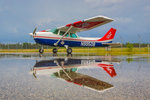
The Chehalis-Centralia Airport will host more than 50 volunteers from seven different Southwest Washington Civil Air Patrol (CAP) squadrons on April 29.
They will participate in a joint search and rescue exercise that was originally scheduled for last Saturday.
John Chapman, emergency services officer for the CAP Fort Vancouver Composite Squadron and a retired U.S. Air Force F-16 pilot, said inclement weather forecasts were the reason for the rescheduling.
“The forecasted cloud cover and freezing level do not support safe flying operations,” Chapman told The Chronicle in an email last week.
Despite not being able to fly and do the full joint search and rescue exercise on Saturday, some CAP volunteers still gathered to participate in training exercises.
Chapman spoke with The Chronicle over the phone on Thursday to break down goals of the full search and rescue exercise in April. The main goal is to get experience for squadron volunteers in communicating and coordinating with each other.
Using the Chehalis-Centralia Airport’s Scott Crossfield Terminal as the emergency command center, CAP volunteers will coordinate search operations during the training exercise. Additionally, some volunteers participating in the search and rescue exercise will be working at the First Christian Church in Centralia where the CAP Lewis County Composite Squadron operates out of.
“We try to have exercises like this one to have aircraft come together, maybe fly an emergency practice mission en route, land there (in Chehalis), turn around and fly additional sorties to exercise our emergency service activities,” Chapman said.
The U.S. Air Force pays for both fuel and planes CAP utilizes, though not every squadron has a designated aircraft.
“Lewis County Composite Squadron actually doesn’t have an aircraft, and they don’t have a lot of aircrew qualified personnel because of that,” Chapman said. “But they have a very active cadet program and are obviously planning to exercise with us too.”
Most squadrons with planes have either a Cessna 172 or 182, which Chapman explained are chosen for their reliability and modern equipment.
“They’re the newest models that have what you would call a glass cockpit. It’s not just round dials and gauges. They are very up-to-date and capable aircraft that we can fly on search and rescue missions and disaster response,” Chapman said.
Both Cessnas are four-seat aircraft, meaning the pilot can concentrate on flying while observers join the pilot to scan terrain searching for missing people, assess structure damage and conduct aerial photography.
Aside from the Cessnas, many CAP squadrons are beginning to utilize drone technology as well, and CAP volunteers will be practicing flying drones during the search and rescue exercise.
Other focuses of the training will be locating lost aircraft beacons and handling media communications, including what information is released and how to release that information during emergencies or sensitive situations.
Chehalis-Centralia Airport Director Brandon Rakes explained what makes the Scott Crossfield Terminal such a great location for a command center. The terminal offers all the amenities CAP volunteers will need in order to be able to coordinate search and rescue exercise operations, such as radios and internet access.
“This is a huge resource for the community,” Rakes said. “If we have a major event and the airport is still in operation, this can become that base of operations for them.”
While the airport is surrounded by a levy to protect it from flooding, the levy was expanded after it was breached in the catastrophic 2007 flood. During the recent January 2022 flooding event, the levy held up.
Despite this, further plans to raise the levy even higher are being considered as part of both the Chehalis Basin Strategy’s Local Action Non-Dam Alternative flood mitigation efforts and the proposed water retention facility near Pe Ell.
“We’re in both of those plans, which was really my primary objective, to just make sure people understand the importance of this resource,” Rakes said.
Aside from the base of operations the terminal offers, the airport has fueling capabilities and maintenance areas. It also boasts a 5,000-foot runway, more than double the length of small, general aviation airport runways that are on average around 2,000 feet long ,according to https://airportllc.com.
With all the extra space, the airport can also be used to stage materials while coordinating emergency operations.
“We have a big, controlled area out here and it’s almost like a giant parking lot. You can get trailers on it and get resources out to people,” Rakes said. “Obviously using it as an airport is ideal, but there are times when you just need a place to put stuff.”
Rakes added he also enjoys doing joint operations, not only with CAP but with the U.S. Army and Air Force, as they help all entities involved get better connected with the community.
CAP is a U.S. Air Force auxiliary made up of volunteers who work mainly to provide search and rescue efforts for everything from lost hikers to natural disasters, but it also provides aerospace education to its cadets who range from 12 to 18 years old.
Once older than 18, volunteers are free to either remain with CAP or pursue other endeavors, such as JROTC programs. CAP doesn’t focus solely on military training and preparation, though there are still some elements of military structure.
For more information on CAP, including how to get involved, visit https://wawg.cap.gov/.